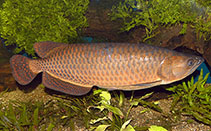| Family: |
Osteoglossidae (Arowanas) |
| Max. size: |
100 cm SL (male/unsexed) |
| Environment: |
pelagic; freshwater |
| Distribution: |
Asia and Oceania: northern Australia and central-southern New Guinea (Ref. 58511). |
| Diagnosis: |
Dorsal spines (total): 0-0; Dorsal soft rays (total): 20-24; Anal spines: 0-0; Anal soft rays: 28-32 |
| Biology: |
Adults occur in still waters of streams and swamps where it is usually seen near the surface or close to shore among aquatic vegetation (Ref. 2847, 44894). Solitary, territorial and spawn prior to the wet season when surface water temperatures approach 30°C (Ref. 44894). Young feed primarily on microcrustaceans (Ref. 2847). Primarily a surface feeder, feeding on a variety of terrestrial and aquatic insects, small fishes, frogs, crustaceans, and some plant material (Ref. 44894). Mouthbrooders (Ref. 56180). Maximum weight reported in Ref. 5259 may be 12.27 kg (W. Lau, pers. Comm. 07/05). Important food fish (Ref. 58511) and a valuable aquarium fish (Ref. 83518). |
| IUCN Red List Status: |
Least Concern (LC); Date assessed: 14 February 2019 Ref. (130435)
|
| Threat to humans: |
harmless |
| Country info: |
|
Source and more info: www.fishbase.org. For personal, classroom, and other internal use only. Not for publication.

